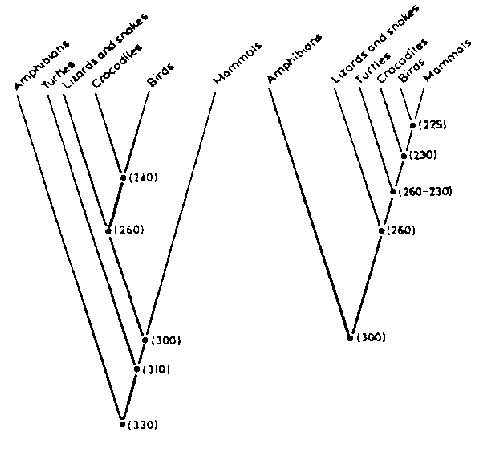 |
Science Frontiers ONLINE No. 36: Nov-Dec 1984 |
|
|
Is a dog more like a lizard or a chicken?
Cladism has been around since at least 1950, when the German entomologist William Hennig began classifying organisms in a new way.
"His method was simple: classifications of animals and plants should be based on an assessment of their characters, and only advanced, or derived, characters (synapomorphies) should be used. For example, the character 'possession of feathers' is a synapomorphy shared by all birds that is found in no other organisms; it is used in classification to define Class Aves. All birds have a backbone too, but that is a primitive character for birds because it is seen in all other vertebrates. Primitive characters are of no use in defining a monophyletic group."
Early on, cladism ignited many fireworks in the biological community. Today, cladism has become quite respectable.
The cladists, however, are now fighting among themselves. One camp draws their "cladograms" (see illustration) using evolutionary theory as a guide. The other side believes that the cladograms should be drawn up first, based only upon actual characters and ignoring the theory of evolution -- let the species fall where they may. When evolutonary theory is omitted in the deliberations, radically different cladograms result. Mammals then seem more closely related to birds than reptiles, for example, as expressed in the illustration. A key connecting character here is mutual warmbloodedness. The shifting of a few lines in a cladogram may seem trivial to the nonbiologist, but saying that man is more closely related to a chicken than a lizard is pretty controversial stuff to the conservative evolutionist.
DNA analysis supports the contention that humans are more closely related to birds than reptiles. Paleontological evidence, however, supports the opposite view. The fight rages on.
(Benton, Mike; "Is a Dog More Like a Lizard or a Chicken?" New Scientist, p. 18, August 16, 1984.)
Comment. It all seems to boil down to morphology in the end. Which is a more faithful record of the development of life through the long eons, the phenotype (what the organism looks like) or the genotype (what the DNA looks like)? This may be a dangerous simplification. Why? Because life just may be shaped by more than DNA.
 | Standard evolution cladogram (left). Cladogram based only on characters (right). The numbers are millions of years before present. |